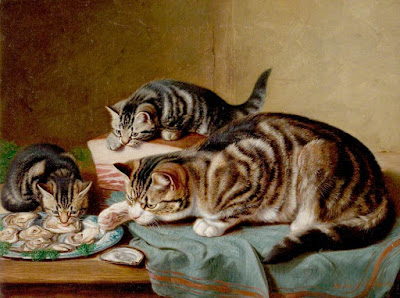Karl Lagerfeld's Cat, Mindfulness, A Dentist's Dilemma
People
 |
An Oyster Supper, Horatio Henry Couldery (1832-1910)
Photo Credit: Nottingham City Museums [CC BY-NC]
|
He flew her everywhere by private jet, gave her diamond necklaces, allowed her to eat from Goyard plates at the table – she likes, “a little bit of caviar” – and hired on her behalf, an on-hand medical adviser, a bodyguard and two ladies in waiting, Francoise and Marjorie. “They play with her, they have to take care of her beautiful white hair, the beauty treatments for her eyes, and they entertain her,” Lagerfeld explained. (Before his death, I might add.)
(Deborah Ross, The Times, 2019)
Would I lie to you?
… Forty
years ago, Kabat-Zinn set about distilling Buddhist wisdom into a framework
that could address modern concerns. He originally designed a short course for
people suffering from chronic physical pain. These programmes have since been
extended to treat a wide range of cases including depression, addiction and
workplace stress.
They have been adopted in schools, businesses, criminal justice systems, in the US military, the NHS and UK parliament. Unless you’ve been living under a rock, you are likely to have encountered them. [I obviously live under a boulder or in a cave.]
Critics of secular mindfulness often argue that it is influenced by Buddhism either too much or not enough. [Ronald] Purser, an ordained Korean Zen teacher, hold the latter view. He regrets that, as mindfulness has grown in popularity, it has been extracted from its Buddhist roots, turned into a product and debased.
According to McMindfulness there are more than 100,000 books on Amazon with “mindfulness” or something similar in the title. The movement has sprouted mindful surfing, mindful bread and mindful KFC chicken pot pies. Mindfulness apps have become big business, and Purser notes that there is a “peculiar irony in turning to an app to de-stress from problems that are often made worse by staring at phones”. As he points out, these superficial, gamified versions of mindfulness are a pale imitation of the real thing.
Purser’s critique cuts deeper. He thinks that mindfulness has not just been diluted and commodified by the market – it is also itself deepening harmful free market ideology. As he sees it, mindfulness claims that “the source of people’s problems is found in their heads”. It thereby distracts from the worldly, societal causes of stress and anxiety.
If you are burnt out from overwork, stressed by precarious employment, or anxious for future generations as a result of climate change, the mindfulness diagnosis is, as Purser puts it, that your “thoughts are the culprit, every time!”. The upshot for him is that mindfulness disables any impetus for collective organisation and action – it implicitly conserves the neoliberal status quo.
… according to Purser, the Californian guru Dawa Tarchin Phillips charges $12,000 for one day of corporate mindfulness training. It’s a far cry from the Buddhist custom of teachers giving their time freely.
(Jonnie Wolf, The Observer, 2019)
They have been adopted in schools, businesses, criminal justice systems, in the US military, the NHS and UK parliament. Unless you’ve been living under a rock, you are likely to have encountered them. [I obviously live under a boulder or in a cave.]
Critics of secular mindfulness often argue that it is influenced by Buddhism either too much or not enough. [Ronald] Purser, an ordained Korean Zen teacher, hold the latter view. He regrets that, as mindfulness has grown in popularity, it has been extracted from its Buddhist roots, turned into a product and debased.
According to McMindfulness there are more than 100,000 books on Amazon with “mindfulness” or something similar in the title. The movement has sprouted mindful surfing, mindful bread and mindful KFC chicken pot pies. Mindfulness apps have become big business, and Purser notes that there is a “peculiar irony in turning to an app to de-stress from problems that are often made worse by staring at phones”. As he points out, these superficial, gamified versions of mindfulness are a pale imitation of the real thing.
Purser’s critique cuts deeper. He thinks that mindfulness has not just been diluted and commodified by the market – it is also itself deepening harmful free market ideology. As he sees it, mindfulness claims that “the source of people’s problems is found in their heads”. It thereby distracts from the worldly, societal causes of stress and anxiety.
If you are burnt out from overwork, stressed by precarious employment, or anxious for future generations as a result of climate change, the mindfulness diagnosis is, as Purser puts it, that your “thoughts are the culprit, every time!”. The upshot for him is that mindfulness disables any impetus for collective organisation and action – it implicitly conserves the neoliberal status quo.
… according to Purser, the Californian guru Dawa Tarchin Phillips charges $12,000 for one day of corporate mindfulness training. It’s a far cry from the Buddhist custom of teachers giving their time freely.
(Jonnie Wolf, The Observer, 2019)
Have I got this right? The original concept of mindfulness
has been bastardised by the market which now proclaims that stress and anxiety
are psychological in nature. They are internal. Purser argues that this idea is
deficient because it does not take into account external societal factors.
Because of this the status quo continues.
Well can’t stress and anxiety be the result of psychological
and societal factors?
(See August 30th)
Letters
 |
| The Dentist, John Lavery (1856-1941) Photo Credit: British Dental Association Dental Museum [CC BY-NC] |
A dentist was about to commence work on a female patient when he paused and said: “You do realise, madam, that you’re holding me in an intimate place?” “Yes,” she replied. “We’re not going to hurt each other, are we?”
(The Times, 2019)

Comments
Post a Comment